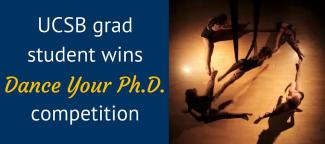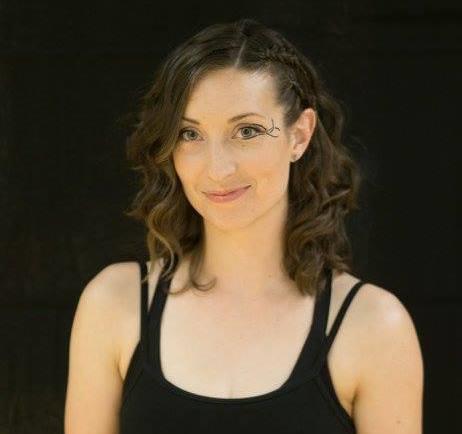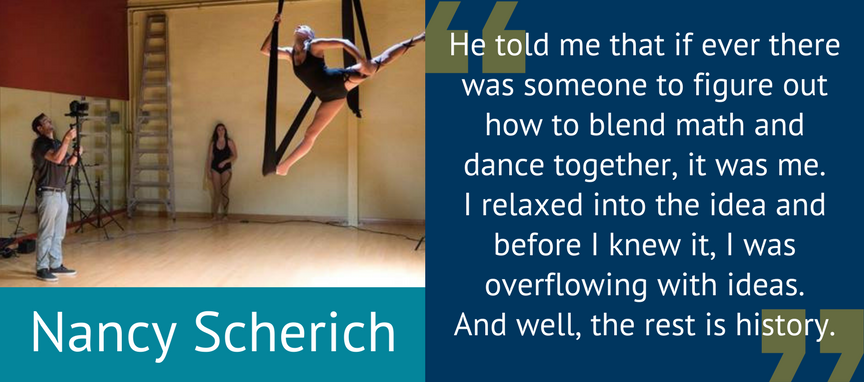Top Stories
Check out UCSB Ph.D. student Nancy Scherich's winning video submission in the Dance Your Ph.D. competition, where she explains her mathematics research using interpretive dance and aerial silks. Congratulations, Nancy!

 You've probably never seen mathematics explained quite like this before. Nancy Scherich, a Ph.D. student in the UCSB Mathematics Department, recently won the 10th annual Dance Your Ph.D. competition with an interpretive dance version of her research using aerial silks. Check out her winning video submission âhere.
You've probably never seen mathematics explained quite like this before. Nancy Scherich, a Ph.D. student in the UCSB Mathematics Department, recently won the 10th annual Dance Your Ph.D. competition with an interpretive dance version of her research using aerial silks. Check out her winning video submission âhere.
We sat down with Nancy to talk about what it feels like to win, how she developed her unique blend of math-dance, and how competing in Dance Your Ph.D. helped bring clarity to her career goals.
HOW IT FEELS TO WINI got the email on Monday morning that I had won, and it was a really lovely moment. I was visiting my family in Kansas City and about to head back to California, which is usually a sad time for me. However, I got the notification right before I left, and my family was screaming and jumping for joy. I am so very overwhelmed with excitement! I put so much effort and love into this project, and it feels amazing to be recognized. |
|
WHAT INSPIRED HER TO COMPETEI've been a dancer my entire life, but my interest in aerial silks is more from my passion for performance and theatrics in general. âThroughout college, I was very focused on mathematics and left my life of dancing and performing behind. After coming to UCSB for my Ph.D., I took a basic aerial silks class at the Recreation Center and I was hooked. Aerial dancing is incredibly empowering with a blend of feminine motion and masculine strength and energy. I've been studying with Lauren Breese with AIREDANSE for just under two years, and we collaborated on the aerial choreography for the video. I've known about âthe Dance Your Ph.D. competition for several years and I've always loved the idea, but I never thought it could be done in my field. Mathematics has a disadvantage over the other scientific subjects because most of the things we study literally do not exist in physical reality. However, this past June, my boyfriend sent me âa link to the competition announcement page and told me that if ever there was someone to figure out how to blend math and dance together, it was me. I relaxed into the idea and before I knew it, I was overflowing with ideas. And well, the rest is history. |
|
ABOUT HER RESEARCHI study abstract representations of the braid groups. Braids themselves actually exist in the physical world as tangles of strings, so it was a natural choice to use silks to portray braids. The first hurdle in communicating mathematics is to make the abstract concepts relevant and relatable to a largely math-phobic society. The challenge then becomes explaining the math concepts with movement instead of the usual format of diagrams and equations. What I've found is that many of the technical words mathematicians use are descriptions of movement: twisting, mapping, flowing, permuting, continuous, change, unwrapping, winding, etc. So it just becomes a matter of converting those words of movement into actual movement. |
|
WHY UCSBI started my Ph.D. at UCSB because I wanted to be at a school with a large group of people studying topology. Also, I grew up in southern California and it didn't bother me one bit to move back to the sunshine and beach! We have a very supportive and collaborative group of students and faculty in the Mathematics Department here. My advisor, Darren Long, is wonderful to work with and keeps me on track. Another one of my committee members, Ken Millett, actually makes a cameo in my Dance Your Ph.D. video in the role of "Logic." Ken has been so supportive and I'm very lucky to have him on my team. |
|
FUTURE PLANS
|
Congratulations, Nancy!
